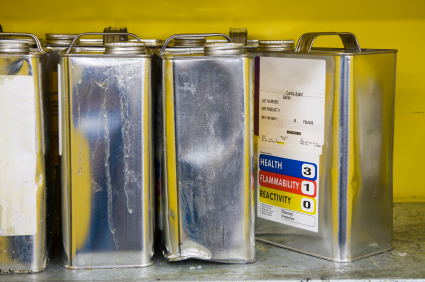Gasoline, paints, glues and solvents all contain a wide variety of volatile organic compounds (VOCs) that may have been inhaled by a driver prior to breath alcohol testing. Numerous breathalyzer experiments have been conducted over the years to determine the effect (if any) of the acute inhalation of volatile organic compounds on breath testing results. The experiments have consisted both of laboratory and reconstruction tests involving gasoline (WOA30612), paints (WOA30608-30611), and white spirits (aka mineral turpentine) (WOA30610).
In one reconstruction experiment, two subjects spray-painted cars over a two day period for seven hours a day. The paint included a veritable alphabet of volatile organic compounds as follows:

As may be expected, the subjects reported suffering from occasional dizziness, nausea and balancing problems after a heavy painting job but these effects quickly dissipated after exposure to fresh air. In addition, no positive Intoxilyzer 5000 test results were obtained after ten minutes exposure to fresh air.
To further corroborate these findings, many years ago I also conducted a reconstruction test on a painter who was charged with driving with a BAC of greater than 0.08 g/100mL after obtaining Breathalyzer results of 0.180 and 0.170 g/100mL. The accused stated that he only had two beers and that the high Breathalyzer results must be due to inhaling paint fumes while working.
One Saturday morning I found myself in the company of a defense expert and a police officer as we sat in a small, ill-ventilated workshop and watched the accused driver slowly paint four large 4’ x 8’ pieces of plywood on both sides. The workshop quickly filled with paint fumes and became quite adverse to breathing. After about one hour of exposure, we conducted Breathalyzer tests on ourselves as control subjects as well as the accused. After 15 minutes exposure to fresh air, all results were zero except for those of the accused who obtained a high result. Unbeknownst to us at the time, he had hidden a bottle of liquor in the tank of the toilet and had consumed it while he was visiting the washroom. This shows that you have to be very cautious when conducting reconstruction tests with an accused driver as they have a great incentive to try to falsify the results and avoid a conviction. In this case, the painter eventually pleaded guilty to driving over 0.08.
As these studies show, volatile organic compounds from paints and other substances leave the breath in an exponential manner similar to the mouth alcohol effect (see my previous blogs). The safeguards against mouth alcohol, such as a 15 to 20 minute deprivation/observation/ arrest period and duplicate breath tests conducted several minutes apart, will prevent falsification of the breath test results from acute inhalation of these vapours. Some breath testing instruments also have an interferent detection system.
As concluded by Imobersteg et al. 1993 (WOA30611):
There is no empirical evidence that occupation exposure to solvents contained in paint products are retained in the lungs such that a false alcohol reading will be registered on the Intoxilyzer 5000. When one considers the quick dissipation of solvents from the lungs, coupled with the 15-min observation requirements for a valid breath test, paint solvent’s effect on the Intoxilyzer 5000 seems remote at best.
For those of you who know me, bringing some creativity to reconstruction tests is something I always prided myself in. However, in one experiment which I considered to be in the height of “bad taste”, we investigated the effect of gasoline in the mouth on breath alcohol testing. This was to simulate a defence that the accused driver had accidentally sucked up gasoline into the mouth while siphoning gasoline from a tank.
An alcohol-free subject rinsed his mouth with unleaded gasoline and then provided breath samples into an IR instrument and obtained the following results (WOA30614):

*Inteferent Detected
It is of interest to note that although the effect of gasoline on the breath test disappeared rapidly, the taste of gasoline remained in his mouth for six to eight hours…leading us to conclude that gargling with gasoline to avoid a DUI is simply in bad taste!





